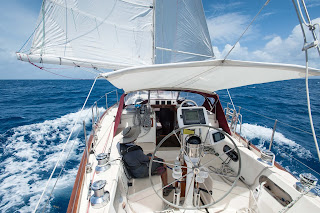Big Sand Cay and the
short hop to Cockburn Harbor, South Caicos
… Tues 24th – Wed 25th
April 2018
It was awesome arriving at Big Sand Cay. The Island is about
two miles long, north to south, and only a few hundred yards wide. It sits
about 15 miles east of the Caicos Bank, is uninhabited and designated a
wildlife refuge. We approached from the south and anchored up close to the west
shore to get as much protection from the wind and swells as possible. The seas
around it are the most intense turquoise blue – it feels like a tropical
paradise perched on the edge of the world. You’d think it would be quiet and
peaceful – think again. It’s certainly peaceful, but with the wind blowing from
20 – 28 knots and thousands of sea birds squawking it’s anything but quiet. We
were thrilled to see so many seabirds – sooty, bridled and black terns, black
noddy, white tailed tropic birds and shearwaters to name but a few. We didn’t
go ashore mostly because we were too lazy to re-inflate and launch the dinghy
only to have to put it away for the trip across Turk Passage to South Caicos
the following day, but with so many nesting seabirds I’m not sure it would have
been such a great idea anyway. So we just stayed on the boat and enjoyed
relaxing. For dinner Gloria made an outstanding meat-loaf which we ate with
sauteed butternut squash and cauliflower, followed by fresh pineapple for
dessert. We worked on writing blogs and editing photos, but needless to say we
didn’t stay up late.
The forecast was for the winds to veer further to the south-east
and intensify overnight. We were concerned that we might get a lot swell
curling round the corners of the island and into the anchorage. We deployed a
second independent anchor from the stern to hold the boat towards the swells. We
went to bed fairly comfortable, but I awoke at 3am with a sense that the motion
of the boat had changed dramatically. Indeed the wind and waves had picked up
and twisted Cotinga so the stern anchor was slack and ineffective. I tightened
things up and went back to bed. At 6am I was wide-awake and fully aware that
conditions had deteriorated further. At 6.45am I woke Gloria so we could get
going before the situation got worse. Both anchors came up with no problem, we
set off with a full main sail, dead down wind to Cockburn harbor, drinking our
morning coffee as we went. About two hours into the trip Gloria (aka “Little
Miss Sunshine”) asked what our back-up plan was if conditions in the “cut” were
too rough to enter safely. In fairness this was a great question ... with no
easy or obvious answers. The next safe harbor is on the other side of the
Caicos Bank about 60 miles away, and if the conditions are too bad to get on to
the bank then you have to sail all the way round the outside. Fortunately,
passing through the cut proved to be easy. The water depth goes from 3000 feet
to 30 feet in the space of a quarter of a mile, which under some circumstances
can create “rage” conditions. Today it was just a bit bumpy and we were through
into crystal clear turquoise water in no time.
The anchorage appears wide open, but much of the surrounding
water shallows to near dryness creating reasonable protection. After a quick
lunch we launched the “dumb dog” and headed to shore to check-in with
immigration and customs. This turned out to be somewhat confusing. We asked a
police officer and he checked with immigration and told us the officer was
coming down to the marina (which is in fact just a store). We waited about half
an hour and eventually the store called her and we were instructed to walk up
to her office about a quarter mile away. We were able to find the office quite
eaily and the lady was very pleasant and helpful. Then the customs officer
drove over from her building, to pick us up and drive us back to her office.
More forms and payments and we were finished. But check this out, the customs
officer then jumped back in her car and drove us back to our dinghy! There
aren’t too many places where I can imagine that happening. Everyone we have met
seems super friendly. We had an early dinner at the local restaurant that
turned out to be excellent – pan fried red snapper and grouper. Now we are back
on board resting! Tomorrow we plan to explore the area.
Mike
Big Sand Cay … 21o 12.0 N, 71o 16.0 W
Cockburn Harbor,
South Caicos … 21o 29.5 N, 71o 32.3 W
A squall to the east of Big Sand Cay
The southern tip of Big Sand Cay
Big Sand Cay looks lovely
Sunset from Big Sand Cay
Sunset from Big Sand Cay




















